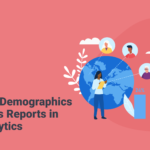What is Google Analytics and how to Use It?
What is Google Analytics?
Google Analytics is a web analytics service that offers key insights on search engine optimization (SEO) and marketing metrics. Anyone with a Google account can take advantage of the free service that is part of the Google Marketing Platform.
Website performance is tracked by Google Analytics, and this data is collected about site visitors. It helps organisations to identify the largest sources of traffic, gauge the success of their marketing efforts, and track goal completions (such as purchases, adding items to carts). When you have small and medium-sized retail websites, Google Analytics is used to gather behavioural data from customers in order to use it for a variety of purposes, including marketing campaigns, site traffic, and website retention.
Also Read: List of Digital Marketing Tool and B2B Saas Marketing Strategies
How does it work?
When Google Analytics captures user data from each visitor using tags on web pages, it obtains that information. Each page on the site has a JavaScript page tag placed within the code. Each visitor to the site uses the tag, which then goes through the visitor’s web browser and sends data to one of Google’s data collection servers. Once Google Analytics has produced customised reports about a variety of different data, such as the number of users, bounce rates, average session durations, sessions by channel, page views, goal completions, and more, Google Analytics is capable of producing custom reports on that data.
Page tags act as web bugs or web beacons, gathering information about the site’s visitors. As a result, this data collection method can only be used by users who have not disabled cookies.
Also Read: How to Optimize Google My Business 2021 and How to Improve your Google Page Speed Insights Score
Google Analytics has numerous features
Google Analytics offers features that enable website users to identify traffic patterns and trends. The data collection, analysis, monitoring, visualisation, reporting, and integration features of features enable the collection, analysis, monitoring, visualisation, reporting, and integration of data. Here are some of the features:
- data visualization and monitoring tools, including dashboards, scorecards and motion charts that display changes in data over time;
- data filtering, manipulation and funnel analysis;
- data collection application program interfaces (APIs);
- predictive analytics, intelligence and anomaly detection;
- Division for analysis of subsets, such as conversions;
- custom reports for advertising, acquisition, audience behaviour and conversion;
- email-based sharing and communication; and
- integration with other products, including Google Ads, Google Data Studio, Salesforce Marketing Cloud, Google AdSense, Google Optimize 360, Google Search Ads 360, Google Display & Video 360, Google Ad Manager and Google Search Console.
Users can create and save website profiles in the Google Analytics dashboard, which allows them to set default categories or use custom metrics for each website. Content Overview, Keywords, Referring Sites, Visitors Overview, Map Overlay, and Traffic Sources Overview are all available for tracking purposes.
View the Google Analytics dashboard on the Analytics site and get the embed code for other sites through a widget or plugin. Google Analytics dashboards that have been customised for the specific requirements of your company are also available from independent vendors.
Also Read: Top 10 Digital Marketing Institutes in Delhi and Why is Content Vital in Digital Marketing
How to Use Google Analytics
To begin collecting basic data from a website:
- Create or register for your Analytics account:
- Go to google, analysis and information.
Make one of these:
- Click Start for free, to create an account.
- Click Log in to Analytics, to log in to your account.
Install your Analytics account for a property. A property is the collection point for your site or application data in Analytics.
Set your property to a reporting view. Views allow you to create filtered perspectives of your data; for instance, all data except internal IP addresses of your company or all data related to a particular area of sales.
You can collect data in your Analytics property, and follow instructions to add the tracking code in your web site.
Next steps
- To determine your access and which data is available, set up your account, properties and views. You can, for instance:
- Give permissions for changing configuration and for interacting with data. Find out more about management of users.
- Connect your Google advertisements and analytics accounts, so that you can share data and learn how your marketing efforts lead users on your websites or applications. Find out more about connecting your accounts.
- Set report views so that analytics users and relevant data can be aligned. Find out more on views.
- Set objectives for identifying and giving the financial value to the actions you want users to take on your website or app. Find out more about target setting.
- Browse the dashboards, custom reports, and segments in your Analytics Account in the Solutions Gallery.
To collect additional data, edit your tracking code:
- User interaction with your website or app’s links, buttons, video controls and others.
- Ecommerce activity such as user involvement in product lists and internal promotions and the success of users in their purchasing and checkout processes. Find out more about data collection and reporting for ecommerce and enhanced business.








